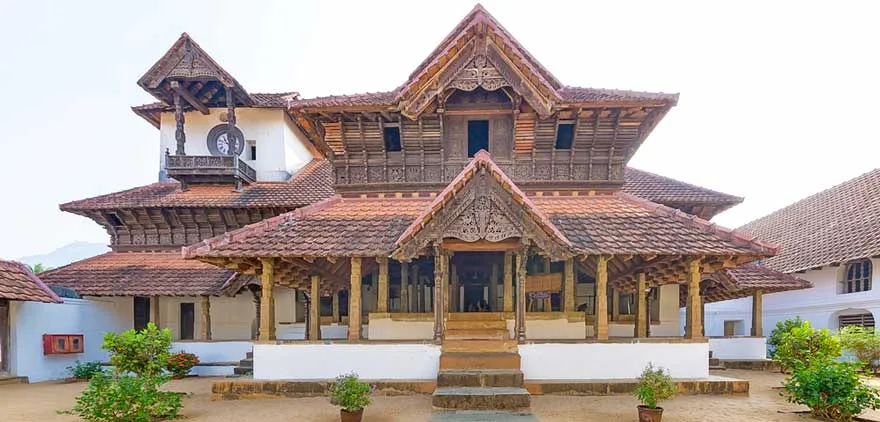Padmanabhapuram Palace

Padmanabhapuram Palace is located in Padmanabhapuram near Thuckalay, Kalkulam Taluk of Kanyakumari District. It is also known as Kalkulam Palace.
Padmanabhapuram was the ancient capital of erstwhile kingdom of Travancore. The town is located at a distance of 20 kilometres from Nagercoil and 60 kilometres from Thiruvananthapuram.
Padmanabhapuram comes under the State premises of Tamil Nadu but is owned by the Government of Kerala. The Palace is maintained by the Govt. of Kerala Archaeology Department.
The opulence of the royal palace and its astounding architecture makes this place a massive tourist attraction.
Origin and Historical Significance of the Palace
The construction of the palace dates back to 1601 AD under the ruler of Venad (a medieval kingdom) Iravi Varma Kulashekara Perumal. The palace was rebuilt in around 1750 AD by King Anizham Thirunal Marthanda Varma. The King dedicated the kingdom to his family deity Sree Padmanabha (a form of Lord Vishnu) and ruler the kingdom as a dasa/servant of Lord Padmanabha. And henceforth the palace came to be known as Padmanabhapuram or the city of Lord Padmanabha.
During the reign of Avittam Tirunal Balarama Varma (successor of Marthanda Varma), the fortifications of the palace were captured and utilized by British soldiers in 1809. With the disclosure of a fortified settlement around the Padmanabha Swamy Temple in Thiruvananthpuram, Padmanabhapuram lost its prominence. The 1850’s marked an accelerated decline of the Palace.
In 1934, with the combined efforts of Sree Chithira Tirunal Balarama Varma (the last Maharaja of Travancore), the Queen Mother Sethu Parvathi Bayi and Dewan Sir. C.P. Ramaswami Aiyer, the palace was bought to the notice of the Archaeology Department. In 1935, the palace was converted into a museum complex.
The Palace & Its Unique Rooms
The Padmanabhapuram Palace, spread around an area of 6.5 acres, consists of many divisions that include:
The Reception Hall – The Poomukha Malika
The Poomukha Malika has a triangular arch that leads to other portions of the complex. The engraved wooden ceiling of the arch has 90 different flower carvings.
Mantrasala – The King’s Council Chamber
The Mantrasala is where the King conducted meetings and took administrative decisions. There are fine carvings on the ceiling and beams of the room. The room also has a single gable and eleven small windows (kilivaadhil).
Queen Mother’s Palace – The Thai Kottaram
The Thai Kottaram is the oldest structure in the complex built in the mid of 19th century. The naalukettu style structure (four halls joined together with a central courtyard open to the sky) is finely engraved.
Natakashala/Navarathri Mandapam – The Performance Hall
The rectangular Performance Hall has ornately carved monolith pillars adorned with bands of floral and geometric patterns and human figures in various Natyasastra postures. The hall is adjoined with a temple dedicated to Goddess Saraswathi.
Central Mansion
At the center of the palace complex is the four-storeyed building that was constructed during the reign of King Mardhanda Varma. Most of the walls in the palace complex have built-in recesses for storage of weapons.
The ground floor of the mansion houses the royal treasury and first floor houses the king’s bedrooms. The second floor has the king’s resting and study rooms. The top floor also called the Upparikka Malika was used as the worship chamber and has exquisite murals decorated on the walls.
Thekke Kottaram – Southern Palace
The Thekke Kottaram is also an old structure like the Thai Kottaram. This complex houses a heritage museum with exhibits of antique household articles and objects.
The Clock Tower
The Clock Tower is situated to the north of the Mantrasala. It was built by a local blacksmith with the sound covering a 3 kilometre radius.
Other Prominent Features of the Palace
- The Palace is a masterpiece of Kerala architecture. The wooden palace with its murals, black granite flooring, intricate floral carvings and sculpted indoors transports the visitors to the ancient past.
- The palace is said to have a secret passage (now blocked) for usage by the kings and his family in case of any emergencies.
- A flight of steps that lead to a bathing pond.
- Visitors can also marvel at the antiques including old Chinese jars, a variety of weapons, furniture, wood and stone sculptures and paintings depicting the history of Travancore.
- The ornamental cot used by the King is said to have been made of about 64 wooden pieces of a variety of medicinal tree trunks.
Padmanabhapuram Palace Visiting Hours & Fee Details
It is open on all days except for Mondays from 9:00 AM to 12:30 PM and from 2:00 PM to 4:30 PM. The Palace is closed on National Holidays. Parking fee of Rs 50 is charged. Visitors can also buy a detailed guide book available in Tamil, English and Malayalam languages, at the ticker counter priced at Rs. 100.
The entrance fee is charged as below:
| Adult | Rs. 35/- |
| Adult (Foreign National) | Rs. 300/- |
| Children (5-12 Yrs) | Rs. 10/- |
| Children (Foreign National) | Rs. 100/- |
| Still Camera | Rs. 50/- |
| Video Camera | Rs. 2500/- |
How to reach Padmanabhapuram Palace
Padmanabhapuram Palace is located 2 kilometres from Thiruvananthapuram-Kanyakumari National Highway (NH 66).
The nearest railway station is at Nagercoil (16 kilometres away) that connects the town with major cities in South India.Trivandrum International Airport is the nearest airport (52 kilometres away).
Epilogue
Padmanabhapuram Palace is a testimony of the traditional style of Kerala architecture. A visit to the place will surely take one to the classic era of the Travancore State.
